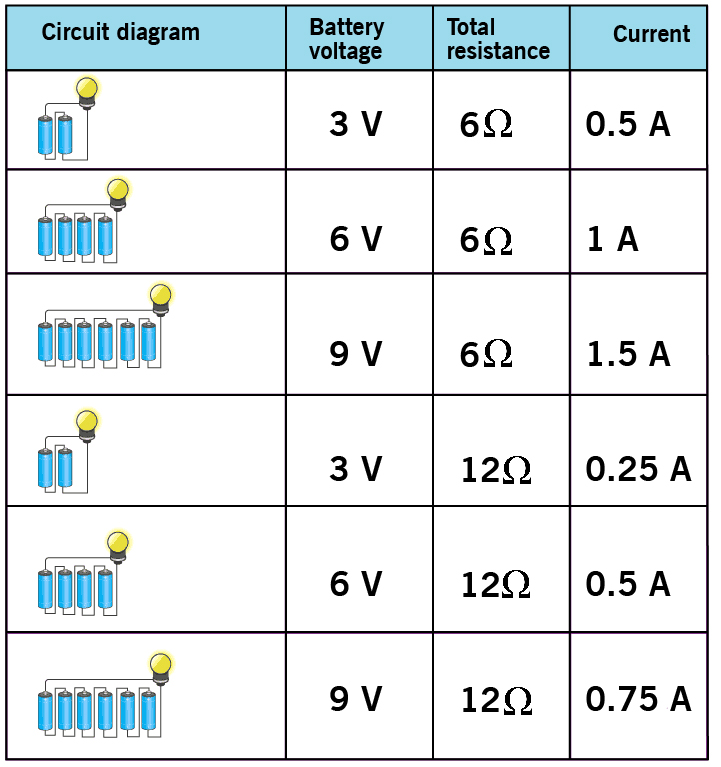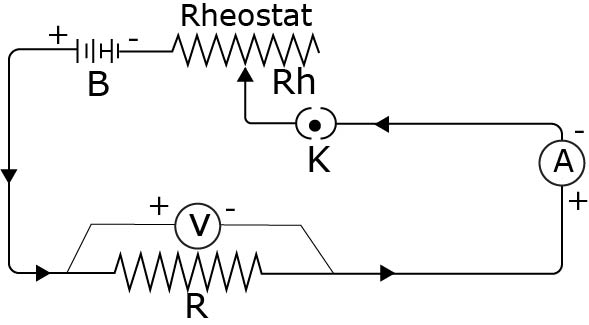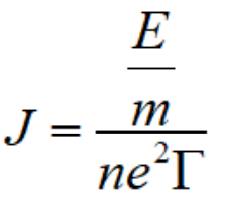
Ohm's Law
Current Electricity of Class 12
Ohm's law is defined as the relationship between electric current and potential difference. The current that flows through most conductors is directly proportional to its voltage. Georg Simon Ohm, a German physicist, was the first to verify Ohm's law experimentally.
Ohm's Law Definition
It states that current flowing between two points in a conductor is directly proportional to the potential difference between the two points.
Ohm's Law Formula
I ∝ V, provided the temperature is constant
V/I = R
or, V = IR
where R is a constant.
The constant 'R' is called resistance of the conductor. Its value depends upon the nature of conductor, its dimensions and the surrounding (e.g. temperature). Ohm's law is not universal (i.e. all conductors do not obey Ohm's law). Conductors obeying Ohm's law are called Ohmic conductors. However, resistance is always defined as the ratio V/I.
For a conductor of cross−sectional area A, resistance between the sections A and B separated by length l is given by, R AB = ρ l/A

where l = length of the conductor
- A = Area of cross−section, and
- ρ = resistivity or specific resistance of the conductor. (Its value depends upon the nature of the material of the conductor and its temperature.)
Unit of Resistance
The SI unit of resistance is ohm. It is denoted by Ω. 1 ohm (Ω) = 1 volt amplere − 1
Conductance
The reciprocal of resistance is called conductance. It is denoted by G.
G = 1 / R; Its SI unit is ohm − 1 or mho or siemen.
Unit of Resistivity
We know that R = ρl / A
ρ = RA / l
In SI system, unit of resistivity = ohm × meter 2 / meter= ohm−metre. or Ω -m
Conductivity
It is defined as the reciprocal of resistivity and it is denoted by σ.
or,σ = 1/ρ
The SI unit of conductivity is ohm -1 metre -1 or siemen m -1
Relationship between Voltage, Current and Resistance

By analyzing series 1, 2, and 3, we understand that doubling and tripling the voltage leads to doubling and tripling the current in the circuit. Similarly, comparing series 1 and 4 and series 2 and 5, we understand that doubling the total resistance halves the circuit's current.
Experimental Verification of Ohm’s Law
The following experiment can verify Ohm’s Law:
Apparatus Required:
- Resistor
- Ammeter
- Voltmeter
- Battery
- Plug Key
- Rheostat
Circuit Diagram:

Procedure:
- Generally, the key K is closed, and the rheostat is set to obtain the minimum reading in ammeter A and voltmeter V.
- The current in the circuit is gradually increased by moving the sliding terminal of the rheostat. During the process, the current flowing through the circuit and the corresponding value of the potential difference across the resistance wire (R) are recorded.
- In this way, different sets of voltage and current values are obtained.
- For each set of V and I values, the V/I ratio is calculated.
- When you calculate the I/O ratio for each case, you will find that it is similarly the same. Therefore, V/I = R, which is a constant.
- Draw a graph of current versus potential differences. It will be a straight line. This shows that the current is proportional to the potential difference.
Calculating Electrical Power Using Ohm’s Law
The energy is converted from the electrical energy of moving charges to some other form of energy such as mechanical energy, heat energy, or energy stored in magnetic fields or electric fields is known as electrical power. The unit of power is the watt. Electrical power can be calculated using Ohm's law and substituting voltage, current, and resistance values.
Power formula
- when the value for voltage and current are given: P = VI
- When the values for voltage and resistance are given: P = V 2 / R
- When the values for current and resistance are given: P = I 2 R
Exceptions of Ohm’s Law
- The conductors which obey Ohm’s law are called Ohmic conductors. The resistance of an Ohmic conductor does not depend upon potential difference or current.
- The current is proportional to the applied potential difference by keeping the physical conditions constant. Thus the V–I graph for an Ohmic conductor is a straight line passing through the origin.
- The conductors which do not obey ohm’s law are called non−Ohmic conductors. For such conductors, the graph between potential difference and current is not a straight line passing through the origin, e.g. vacuum tubes, semiconductors, etc.
Microsopic form of Ohm’s Law
We know that, i = neAv d and v d = eE/m τ
i = neA τ
or,J = i/A = ne 2 E/mτ

or,J = E/ρ where ρ = m/ne 2 τ
or, J = σE [σ = 1/ρ ]
which is the microscopic form of Ohm’s law.
Application of Ohm's Law
The main applications of Ohm's law are:
- To determine the voltage, current or resistance of an electrical circuit.
- Ohm's law maintains the desired voltage drop across electronic components.
- Ohm's law is also used in the DC ammeter and other DC shunts to shunt current.
Limitations of Ohm's Law
Below are the limitations of Ohm's law:
- Ohm's law does not apply to single-ended electrical elements such as diodes and transistors because they allow the electric current to flow in one direction only.
- For non-linear electrical elements with parameters such as capacitance, resistance, etc., the ratio of voltage to current will not be constant to time, making Ohm's law difficult to use.
Solved Examples
Q1. If the resistance of iron is 40 Ω and a current of 3.2 A flows through the resistance. Find the voltage between two points.
Ans. Given that R= 40 Ω
I = 3.2A
Now,
V = I × R
Substituting the given values we get,
V = 3.2 A × 40 Ω = 128 V
V = 128V
Q2. An EMF source of 10 V is connected to a light bulb. An electric current of 5 A flows through it. Consider the conducting wires to be resistance-free. Find the resistance offered by the electrical appliance.
Ans. Given, V = 10 V
I = 5 A
R = V ÷ I
R = 10 V ÷ 5 A = 2 Ω
R = 2 Ω
Frequently Asked Question (FAQs)
Q1. State Ohm's Law?
Ans. The current through a conductor between the two points is directly proportional to the voltage applied across those two points.
Q2. What is the SI unit of Ohm's law?
Ans. The SI unit of electric resistance is the Ohm (Ω).
Q3. Who invented Ohm's law?
Ans. Georg Ohm, in full Georg Simon Ohm (born March 16, 1789, Erlangen, Bavaria [Germany]—died July 6, 1854, Munich), was a German physicist who discovered the law.
Q4. Why is Ohm's law important?
Ans. Ohm's law is important for describing electric circuits because it relates the voltage to the current, with the resistance value moderating the relationship between the two.
Q5. What happens if resistance is too low?
Ans. If resistance is too low, current will be high at any voltage. If resistance is too high, the current will be low if voltage is okay.




